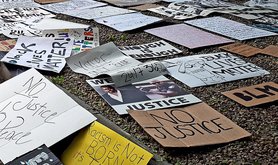
Why is White Fragility so popular?
Robin DiAngelo’s bestselling theories may do little to promote anti-racist activism.

Robin DiAngelo’s book White Fragility has been getting a lot of attention as more people look to understand the persistent and urgent issue of systemic racism. Her tenacious, no-nonsense attitude has won DiAngelo many admirers, making her book a number one New York Times bestseller that plenty of reviewers love. Clearly, many people are eager to embrace it.
But in addition to all the praise, the book has also been heavily criticized. Linguistics professor John McWhorter goes so far as to call it racist. Does white fragility theory stand up to scrutiny, and perhaps more importantly, does it lead white people to understand racism and practice anti-racism in effective ways?
DiAngelo first introduced her theory in a paper written in 2011, arguing that in North America an “insulated environment of racial protection builds white expectations for racial comfort while at the same time lowering the ability to tolerate racial stress, leading to what I refer to as White Fragility.”
She says that white people intensely dislike being forced to recognize their unearned privilege and complicity in systemic racism, and offers many examples of discomfort from her anti-racism trainings such as white participants slamming desks, crying, and even appearing to have a heart attack.
She also speculates that many white readers are trying to prove their anti-racist credentials by buying the book without seriously engaging in the inner work of understanding their complicity in white supremacy (a term she uses in a different way to how it’s popularly understood). Might there be other dynamics in play as well?
Psychologist Yoel Inbar and colleagues have found evidence for a pattern that might shed light on the answers to this question. They call it “moral masochism,” using a term originally proposed by Sigmund Freud.
Inbar’s researchers asked one group of participants to recall an experience that made them feel guilty. People in this group went on to give themselves significantly stronger electric shocks than participants in a second group who had been asked to think about a sad experience, or those in a third, neutral experience control group. Women also gave themselves stronger shocks than men.
“The stronger the shocks participants gave themselves,” Inbar reports, “the more their feelings of guilt were alleviated.” Other studies using brain scans have found that feeling guilt and shame can generate activity patterns that seem to be related to a sense of reward.
Is there an element of this kind of moral masochism that’s driving white people toward White Fragility? Does it alleviate guilt and feel rewarding to experience the pain of thinking of oneself as unintentionally racist, or contributing to white supremacy?
If so, this phenomenon might not be new. Back in 1969, civil rights hero Bayard Rustin argued that “Negroes have been used and exploited in many ways by white Americans, but it is only recently that they have been asked to satisfy the masochistic craving of disenchanted liberals for flagellation and rejection.”
Much of what DiAngelo is describing sounds like an analysis of the broader issue of denial. It’s common in conflicts of all sorts for the parties to have differing beliefs about events, and for one or both of them to be in denial, even when they have all the evidence they reasonably need to prove that their version of events is incorrect.
The work of an earlier sociologist, Stanley Cohen, is helpful here. Cohen explains the dynamics of denial and shows that it is pervasive across many different contexts. Denial tactics help us to feel good about ourselves even while we continue to cause brutal harm to others. As he argues, “Denial may be neither a matter of telling the truth nor intentionally telling a lie. There seem to be states of mind, or even whole cultures, in which we know and don’t know at the same time.”
One key technique of denial is rationalization. Behavioral economist Dan Ariely has studied rationalization through experiments that explore how people cheat on tests. He found that morality is less about having consistent values and sticking with them, and more about telling ourselves stories that help us rationalize our inconsistencies.
A good story lets us cheat on tests for a financial reward, and still firmly believe that what we did was fair - that we are honest people, not cheaters. Such stories are important in allowing these inconsistencies to fit together. They work best when the situation at hand is ambiguous, because ambiguity creates more wiggle room for our rationalizing stories to fill. Addressing this and other techniques of denial is tricky, but it can be done.
While DiAngelo advocates that white people take a highly analytical approach to the issues of racism and white fragility, there may be other, more effective (although still far from perfect) options such as strengthening and extending contact between people of different races, deep canvassing, and Nonviolent Communication. Research and experience suggests that helping someone to overcome racist denial may require listening to them, as well as understanding and reframing the issues at stake in terms of that person’s feelings, needs, and values.
Studies show that people can hold racial biases they aren’t consciously aware of, but it’s unclear how this impacts their behavior. Trainings that claim to reduce these implicit biases may not achieve very much. Research has also found that not all white people display implicit racial bias, and that both explicit and implicit bias can be reduced to very low levels by giving white people information that helps them see people of color as unique individuals and not just as members of a group.
Why does highlighting people’s individuality and promoting the right kinds of contact have a positive effect on racial bias? One theory is that it reduces discomfort when white people interact with a member of another race, turning them from something to feel unsure about or threatened by into someone whose presence is normal and predictable.
Because it consciously seeks to amplify the discomfort of white people, I’m curious to know how White Fragility relates to these findings. For some white readers, the book’s focus on critical self-analysis and the differences between white people and people of color might lead to increased anxiety when interacting with them. If so, might this block the racial-bias-reducing benefits of such interactions by making them feel less habitual and normal, and more like a sensitive ‘performance’ with high stakes - as less of a chat between unique individuals with shared goals and more of an encounter with an emphasis on racial group identities?
There’s an additional and related drawback that arises here: lived experiences are absolutely important, but in white fragility theory subjective opinions and experiences are valued by virtue of racial identity alone, without additional testable or falsifiable criteria. As McWhorter says in his critique of DiAngelo’s book:
“[I don’t] need wider society to undergo teachings in how to be exquisitely sensitive about my feelings. I see no connection between DiAngelo’s brand of reeducation and vigorous, constructive activism in the real world on issues of import to the Black community. And I cannot imagine that any Black readers could willingly submit themselves to DiAngelo’s ideas while considering themselves adults of ordinary self-regard and strength. Few books about race have more openly infantilized Black people than this supposedly authoritative tome.”
The danger here is that diversity is not addressed. Work that claims to be sensitive to the special needs of oppressed groups implies that members of those groups all see themselves in that same light, and want or need such treatment. In reality, some individuals seem to, while others like McWhorter emphatically do not.
I think McWhorter is right in questioning whether DiAngelo’s theories can motivate sustained anti-racist activism. Naming problems is vital, and DiAngelo offers one analysis that may help some readers to understand the issues and perhaps take action. On the other hand, she focuses mostly on interpersonal interactions and says in her lectures that “Our work will never be finished.” That could easily be discouraging and disempowering.
Evidence from positive psychology, experiments on student activism, and the advice of life-long activists all point to the need to go beyond dwelling on the problem. Instead, activists need to feel good about their potential to create change with a positive vision to guide them. There are many positive racial justice visions already out there - here’s one example.
Does White Fragility make race a more or less salient factor when white people interact with people of color, and with what effects? Does it change voting patterns, increase engagement in Black-led racial justice activism, or otherwise empower positive action toward systemic changes?
How do DiAngelo’s theories tangibly reduce prejudices and for whom - and do personality factors, socioeconomic status, political leanings or other variables also make a difference? Does her self-focused approach change behaviors in positive ways or increase anxiety, self-absorption, or other habits that we know are detrimental to health, wellbeing, and political engagement?
At present we don’t have the answers to these questions, but if White Fragility continues to play a key role in discussions about anti-racism they need to be studied very carefully.
Read more
Get our weekly email




Comments
We encourage anyone to comment, please consult the oD commenting guidelines if you have any questions.